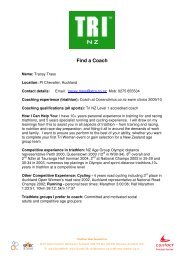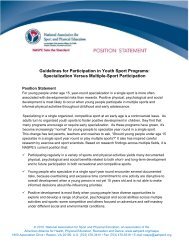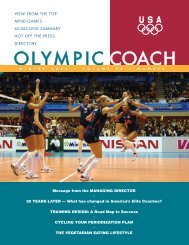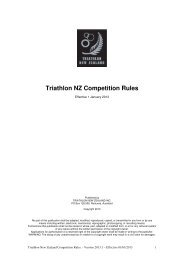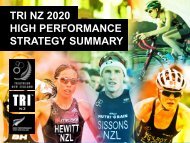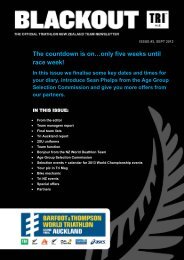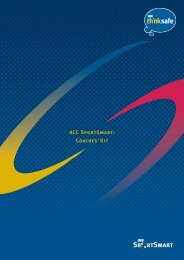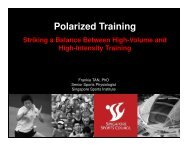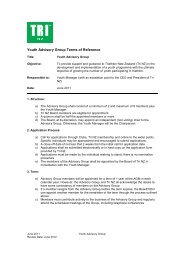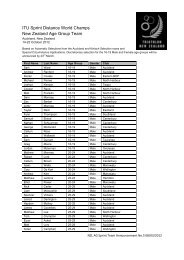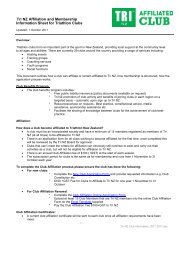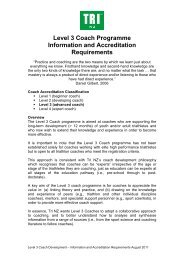The Science of Cycling - IngentaConnect
The Science of Cycling - IngentaConnect
The Science of Cycling - IngentaConnect
Create successful ePaper yourself
Turn your PDF publications into a flip-book with our unique Google optimized e-Paper software.
<strong>The</strong> <strong>Science</strong> <strong>of</strong> <strong>Cycling</strong>: Part 1 309<br />
23. Lindsay FH, Hawley JA, Myburgh KH, et al. Improved athletic 45. Faria IE, Faria EW, Roberts S, et al. Comparison <strong>of</strong> physical and<br />
performance in highly trained cyclists after interval training. physiological characteristics in elite young and mature cy-<br />
Med Sci Sports Exerc 1996; 28: 1427-34 clists. Res Q Exerc Sports Sci 1989; 60: 388-95<br />
24. Lucía A, Hoyos J, Pérez M, et al. Inverse relationship between 46. Lucía A, Pardo J, Durantez A, et al. Physiological differences<br />
˙VO2max and economy/efficiency in world-class cyclists. Med between pr<strong>of</strong>essional and elite road cyclists. Int J Sports Med<br />
Sci Sports Exerc 2002; 34: 2079-84 1998; 19: 342-8<br />
25. Lucía A, Hoyos J, Chicharro JL. Preferred pedaling cadence in 47. Saltin B. Anaerobic capacity: past, present and prospective. In:<br />
pr<strong>of</strong>essional cycling. Med Sci Sports Exerc 2001; 33: 1361-6 Taylor AW, Gollinck PD, Green HJ, et al. editors. Biochemis-<br />
26. Marsh AP, Martin PE. Effect <strong>of</strong> cycling experience, aerobic try <strong>of</strong> exercise VII. Champaign (IL): Human Kinetics, 1990:<br />
power, and power output on preferred and most economical 387-413<br />
cycling cadences. Med Sci Sports Exerc 1997; 29: 1225-32 48. Swain DP. <strong>The</strong> influence <strong>of</strong> body mass in endurance bicycling.<br />
27. MacRae HS-H, Hise KJ, Allen PJ. Effects <strong>of</strong> front and dual Med Sci Sports Exerc 1994; 26: 58-63<br />
suspension mountain bike systems on uphill cycling perform-<br />
49. Hawley JA, Noakes TD. Peak power output predicts maximal<br />
ance. Med Sci Sports Exerc 2000; 32: 1276-80<br />
oxygen uptake and performance in trained cyclists. Eur J Appl<br />
28. Padilla S, Mujika I, Orbananos J, et al. Exercise intensity and Physiol 1992; 65: 79-83<br />
load during mass-start stage races in pr<strong>of</strong>essional road cycling.<br />
50. Sjodin B, Jacobs I. Onset <strong>of</strong> blood lactate accumulation and<br />
Med Sci Sports Exerc 2001; 33: 796-802<br />
marathon running performance. Int J Sports Med 1981; 2: 23-6<br />
29. Romer LE, McConnell AK, Jones DA. Inspiratory muscle fatigue<br />
in trained cyclists: effects <strong>of</strong> inspiratory muscle training.<br />
51. Kuipers H, Verstappen FTJ, Keizer HA, et al. Variability <strong>of</strong><br />
Med Sci Sports Exerc 2002; 34: 785-92<br />
aerobic performance in the laboratory and its physiological<br />
correlates. Int J Sports Med 1985; 6: 197-201<br />
30. Schabort EJ, Hawley JA, Hopkins WG, et al. A new reliable<br />
laboratory test <strong>of</strong> endurance performance for road cyclists. 52. Fohrenbach R, Mader A, Hollmann W, et al. Determination <strong>of</strong><br />
Med Sci Sports Exerc 1998; 30: 1744-50<br />
endurance capacity and prediction <strong>of</strong> exercise intensities for<br />
31. Stepto NK, Martin DT, Fallon KE, et al. Metabolic demands <strong>of</strong> training and competition in marathon runners. Int J Sports Med<br />
intense aerobic interval training in competitive cyclists. Med 1987; 8: 11-8<br />
Sci Sports Exerc 2001; 33: 303-10<br />
53. Stegmann H, Kindermann W. Comparison <strong>of</strong> prolonged exer-<br />
32. Swensen TC, Harnish CR, Beitman L, et al. Non-invasive cise tests at the individual anaerobic threshold and the fixed<br />
estimation <strong>of</strong> the maximal lactate steady state in trained cy- anaerobic threshold <strong>of</strong> 4 mmol/l-1 lactate. Int J Sports Med<br />
clists. Med Sci Sports Exerc 1999; 31: 742-6<br />
1982; 3: 105-10<br />
33. Latin RW, Berg KE, Smith P, et al. Validation <strong>of</strong> a cycle 54. Sjodin B, Svedenhag J. Applied physiology <strong>of</strong> marathon runergometry<br />
equation for predicting steady-rate ˙VO2. Med Sci ning. Sports Med 1985; 2: 83-99<br />
Sports Exerc 1993; 25: 970-4<br />
55. Palmer GS, Hawley JA, Dennis SC, et al. Heart rate response<br />
34. Lucía A, Hoyos J, Santalla A, et al. Kinetics <strong>of</strong> ˙VO2 in pr<strong>of</strong>es- during a 4-d cycle stage race. Med Sci Sports Exerc 1994; 26:<br />
sional cyclists. Med Sci Sports Exerc 2002; 34: 320-5<br />
1278-83<br />
35. McCole SD, Claney K, Conte JC, et al. Energy expenditure 56. Lucía A, Hoyos J, Chicharro JL. Physiology <strong>of</strong> pr<strong>of</strong>essional<br />
during bicycling. J Appl Physiol 1990; 68: 748-53 cycling. Sports Med 2001; 31: 325-37<br />
36. Baron R. Aerobic and anaerobic power characteristics <strong>of</strong> <strong>of</strong>f- 57. Horowitz JF, Sidossis LS, Coyle EF. High efficiency <strong>of</strong> type I<br />
road cyclists. Med Sci Sports Exerc 2001; 33: 1387-93 muscle fibers improves performance. Int J Sports Med 1994;<br />
37. Palmer GS, Noakes TD, Hawley JA. Effects <strong>of</strong> steady-state 15: 152-7<br />
versus stochastic exercise on subsequent cycling performance. 58. Coyle EF, Sidossis LS, Horowitz JF, et al. <strong>Cycling</strong> efficiency is<br />
Med Sci Sports Exerc 1997; 29: 684-7<br />
related to the percentage <strong>of</strong> type I muscle fibers. Med Sci<br />
38. Padilla S, Mujika I, Cuesta G, et al. Level ground and uphill Sports Exerc 1992; 24: 782-8<br />
cycling ability in pr<strong>of</strong>essional road cycling. Med Sci Sports<br />
59. Lucía A, Carvajal A, Calderon FS, et al. Breathing pattern in<br />
Exerc 1999; 31: 878-85<br />
highly competitive cyclists during incremental exercise. Eur J<br />
39. Impellizzeri F, Sassi A, Rodriguez-Alonso M, et al. Exercise Appl Physiol 1999; 79: 512-21<br />
intensity during <strong>of</strong>f-road cycling competitions. Med Sci Sports<br />
60. Harms GA. Effect <strong>of</strong> skeletal muscle demand on cardiovascular<br />
Exerc 2002; 34: 1808-13<br />
function. Med Sci Sports Exerc 2000; 32: 94-9<br />
40. Liedl MA, Swain DP, Branch D. Physiological effects <strong>of</strong> constant<br />
versus variable power during endurance cycling. Med Sci<br />
61. Wilber RL, Zawadzki KM, Kearney JT, et al. Physiological<br />
Sports Exerc 1999; 31: 1472-7<br />
pr<strong>of</strong>iles <strong>of</strong> elite <strong>of</strong>f-road and road cyclists. Med Sci Sports<br />
Exerc 1997; 29: 1090-4<br />
41. Laursen PB, Shing CM, Peake JM, et al. Interval training<br />
program optimization in highly trained endurance cyclists. 62. Foxdal P, Sjodin B, Sjodin A, et al. <strong>The</strong> validity and accuracy <strong>of</strong><br />
Med Sci Sports Exerc 2002; 34: 1801-7<br />
blood lactate measurements for prediction <strong>of</strong> maximal endur-<br />
42. Takaishi T, Ishida K, Katayama K, et al. Effect <strong>of</strong> cycling<br />
ance running capacity. Int J Sports Med 1994; 15: 89-95<br />
experience and pedal cadence on the near-infrared spectroscoperformance.<br />
Sports Med 1986; 3: 10-25<br />
63. Jacobs I. Blood lactate: implications for training and sports<br />
py parameters. Med Sci Sports Exerc 2002; 34: 2062-71<br />
43. British Association <strong>of</strong> Sport <strong>Science</strong>s (Sports Physiology Secaerobic-anaerobic<br />
64. Kindermann W, Simon G, Keul J. <strong>The</strong> significance <strong>of</strong> the<br />
tion). Position statement on the physiological assessment <strong>of</strong><br />
transition for the detection <strong>of</strong> work load<br />
the elite competitor. 2nd ed. Leeds: British Association <strong>of</strong> intensities during endurance training. Eur J Appl Physiol 1979;<br />
Sport <strong>Science</strong>s (Sports Physiology Section), 1988<br />
52: 25-34<br />
44. Coyle EF, Feltner ME, Kautz SA. Physiological and bi- 65. Keith SP, Jacobs I, McLellan TM. Adaptations to training at the<br />
omechanical factors associated with elite endurance cycling individual anaerobic threshold. Eur J Appl Physiol 1992; 65:<br />
performance. Med Sci Sports Exerc 1991; 23: 93-107 316-23<br />
© 2005 Adis Data Information BV. All rights reserved. Sports Med 2005; 35 (4)



